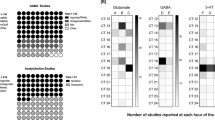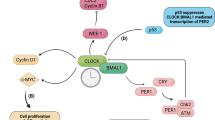Abstract
The effectiveness and toxicity of many drugs vary depending on the relationship between the dosing schedule and the 24-hour rhythms of biochemical, physiological and behavioral processes. In addition, several drugs can cause alterations to the 24-hour rhythms leading to illness and altered homeostatic regulation. However, the mechanisms of this drug-based disruption of circadian 'clock' genes remain unclear. Here, we show the disruptive effect of interferon-α on the rhythm of locomotor activity, body temperature and clock-gene mRNA expression in the periphery and suprachiasmatic nuclei, a primary circadian pacemaker. The rhythmicity of clock genes and the photic induction of the Per gene in suprachiasmatic nuclei were disturbed by the repetitive administration of interferon-α. Moreover, alteration of clock function, a new concept of adverse effects, can be overcome by optimizing the dosing schedule to minimize adverse drug effects.
This is a preview of subscription content, access via your institution
Access options
Subscribe to this journal
Receive 12 print issues and online access
$209.00 per year
only $17.42 per issue
Buy this article
- Purchase on Springer Link
- Instant access to full article PDF
Prices may be subject to local taxes which are calculated during checkout






Similar content being viewed by others
References
Moore, R.Y. & Eichler, V.B. Loss of a circadian adrenal corticosterone rhythm following suprachiasmatic lesions in the rat. Brain Res. 42, 201–206 (1972).
Shigeyoshi, Y. et al. Light-induced resetting of a mammalian circadian clock is associated with rapid induction of the mPer1 transcript. Cell 91, 1043–1053 (1997).
Jin, X. et al. A molecular mechanism regulating rhythmic output from the suprachiasmatic circadian clock. Cell 96, 57–68 (1999).
Kalsbeek, A., van Heerikhuize, J.J., Wortel, J. & Buijs, R.M. A diurnal rhythm of stimulatory input to the hypothalamo-pituitary-adrenal system as revealed by timed intrahypothalamic administration of the vasopressin V1 antagonist. J. Neurosci. 16, 5555–5565 (1996).
Tei, H. et al. Circadian oscillation of a mammalian homologue of the Drosophila period gene. Nature 389, 512–516 (1997).
Zylka, M.J., Shearman, L.P., Weaver, D.R. & Reppert, S.M. Three period homologs in mammals: differential light responses in the suprachiasmatic circadian clock and oscillating transcripts outside of brain. Neuron 20, 1103–1110 (1998).
Ripperger, J.A., Shearman, L.P., Reppert, S.M. & Schibler, U. Clock, an essential pacemaker component, controls expression of the circadian transcription factor DBP. Genes Dev. 14, 679–689 (2000).
Kume, K. et al. mCRY1 and mCRY2 are essential components of the negative limb of the circadian clock feedback loop. Cell 98, 193–205 (1999).
Halberg, F. Chronobiology. Annu. Rev. Physiol. 31, 675–725 (1969).
Reinberg, A. & Halberg, F. Circadian chronopharmacology. Annu. Rev. Pharmacol. 11, 455–492 (1971).
Lemmer, B., Scheidel, B. & Behne, S. Chronopharmacokinetics and chronopharmacodynamics of cardiovascular active drugs: propranolol, organic nitrates, nifedipine. Ann. NY Acad. Sci. 618, 166–181 (1991).
Labrecque, G. & Belanger, P.M. Biological rhythms in the absorption, distribution, metabolism and excretion of drugs. Pharmacol. Ther. 52, 95–107 (1991).
Duncan, W.C. Circadian rhythms and the pharmacology of affective illness. Pharmacol. Ther. 71, 253–312 (1996).
Akiyama, M. et al. Inhibition of light- or glutamate-induced mPer1 expression represses the phase shifts into the mouse circadian locomotor and suprachiasmatic firing rhythms. J. Neurosci. 19, 1115–1121 (1999).
Horikawa, K. et al. Nonphotic entrainment by 5-HT1A/7 receptor agonists accompanied by reduced Per1 and Per2 mRNA levels in the suprachiasmatic nuclei. J. Neurosci. 20, 5867–5873 (2000).
Fattovich, G. et al. A survey of adverse events in 11241 patients with chronic viral hepatitis treated with alfa interferon. J. Hepatol. 24, 38–47 (1996).
Jansenn, H.L.A., Brouwer, J.T., Mast, R.C. & Schalm, S.W. Suicide associated with alfa-interferon therapy for chronic viral hepatitis. J. Hepatol. 21, 241–243 (1994).
Koyanagi, S., Ohdo, S., Yukawa, E. & Higuchi, S. Chronopharmacological study of interferon-α in mice. J. Pharmacol. Exp. Ther. 283, 259–264 (1997).
Roosth, J., Pollard, R.B., Brown, S.L. & Meyer, W.J. Cortisol stimulation by recombinant interferon-α2. J. Neuroimmunol. 12, 311–316 (1986).
Koren, S., Whorton, E.B. & Fleischmann, W.R. Circadian dependence of interferon antitumor activity in mice. J. Natl. Cancer Inst. 85, 1927–1932 (1993).
Kumar, R. & Korutla, L. Induction of expression of interferon-stimulated gene factor-3 (ISGF-3) proteins by interferons. Exp. Cell Res. 216, 143–148 (1995).
Balsalobre, A. et al. Resetting of circadian time in peripheral tissues by glucocorticoid signaling. Science 289, 2344–2347 (2000).
Takahashi, J.S. Molecular neurobiology and genetics of circadian rhythms in mammals. Annu. Rev. Neurosci. 18, 531–553 (1995).
Lohmann, C.P. et al. Severe loss of vision during adjuvant interferon alfa-2b treatment for malignant melanoma. Lancet 353, 1326 (1999).
Purvin, V.A. Anterior ischemic optic neuropathy secondary to interferon-α. Arch. Ophthalmol. 113, 1041–1044 (1995).
Nagayama, H., Takagi, A. & Takahashi, R. Circadian fluctuation of susceptibility to haloperidol under constant conditions. Experientia 43, 625–626 (1987).
Lu, J.Q. & Nagayama, H. Circadian rhythm in the function of central 5-HT1A receptors is endogenous in nature. Cell. Mol. Life Sci. 53, 224–226 (1997).
Ohdo, S., Ogawa, N., Nakano, S. & Higuchi, S. Influence of feeding schedule on the chronopharmacological aspects of sodium valproate in mice. J. Pharmacol. Exp. Ther. 278, 74–81 (1996).
Jones, C.R. et al. Familial advanced sleep-phase syndrome: a short-period circadian rhythm variant in humans. Nature Med. 5, 1062–1065 (1999).
Damiola, F. et al. Restricted feeding uncouples circadian oscillators in peripheral tissues from the central pacemaker in the suprachiasmatic neucleus. Genes Dev. 14, 2950–2961 (2000).
Boulos, Z. & Terman, M. Food availability and daily biological rhythms. Neurosci. Biobehav. Rev. 4, 119–131 (1980).
Ueyama, T. et al. Suprachiasmatic nucleus: a central autonomic clock. Nature Neurosci. 2, 1051–1053 (1999).
Silver, R., LeSauter, J., Tresco, P.A. & Lehman, M.N. A diffusible coupling signal from the transplanted suprachiasmatic nucleus controlling circadian locomotor rhythms. Nature 382, 810–813 (1996).
Takane, H. et al. Chronopharmacology of antitumor effect induced by interferon-β in tumor-bearing mice. J. Pharmacol. Exp. Ther. 294, 746–752 (2000).
Ohdo, S. et al. Basis for dosing time-dependent changes in the antiviral activity of interferon-α in mice. J. Pharmacol. Exp. Ther. 294, 488–493 (2000).
Hunter, C.A. et al. Type I interferons enhance production of IFN-γ by NK cells. Immunol. Lett. 59, 1–5 (1997).
Branca, A.A. & Baglioni, C. Evidence that types I and II interferons have different receptors. Nature 294, 768–770 (1981).
Lundkvist, G.B. et al. Expression of an oscillating interferon-γ receptor in the suprachiasmatic nuclei. Neuroreport 9, 1059–1063 (1998).
Iacobelli, S. et al. A phase I study of recombinant interferon-α administered as a seven-day continuous venous infusion at circadian-rhythm modulated rate in patients with cancer. Am. J. Clin. Oncol. 18, 27–31 (1995).
Bocci, V. Administration of interferon at night may increase its therapeutic index. Cancer Drug Deliv. 2, 313–318 (1985).
Acknowledgements
This study was supported by a Grant-in-Aid for Scientific Research (C) from the Ministry of Education, Science, Sports and Culture, Japan (S.O., 00223884), a Grant-in-Aid from the Tokyo Biochemical Research Foundation (S.O.), a Grant-in-Aid from the Nakatomi Foundation (S.O.) and a Grant-in-Aid from Japan Research Foundation for Clinical Pharmacology (S.O.).
Author information
Authors and Affiliations
Corresponding author
Rights and permissions
About this article
Cite this article
Ohdo, S., Koyanagi, S., Suyama, H. et al. Changing the dosing schedule minimizes the disruptive effects of interferon on clock function. Nat Med 7, 356–360 (2001). https://doi.org/10.1038/85507
Received:
Accepted:
Issue Date:
DOI: https://doi.org/10.1038/85507
This article is cited by
-
Zika Virus Infection Alters the Circadian Clock Expression in Human Neuronal Monolayer and Neurosphere Cultures
Cellular and Molecular Neurobiology (2024)
-
A circadian based inflammatory response – implications for respiratory disease and treatment
Sleep Science and Practice (2017)
-
Interplay between circadian clock and viral infection
Journal of Molecular Medicine (2017)
-
Melatonin, clock genes and mitochondria in sepsis
Cellular and Molecular Life Sciences (2017)
-
Circadian Clocks and Inflammation: Reciprocal Regulation and Shared Mediators
Archivum Immunologiae et Therapiae Experimentalis (2014)



